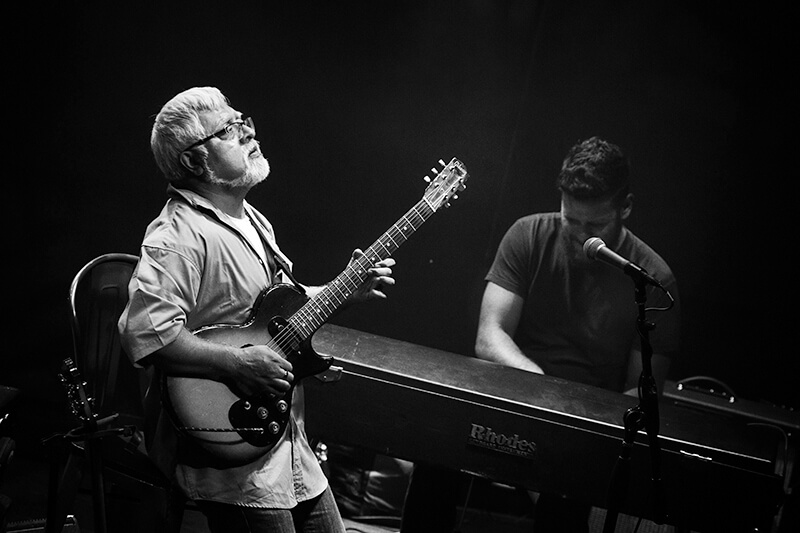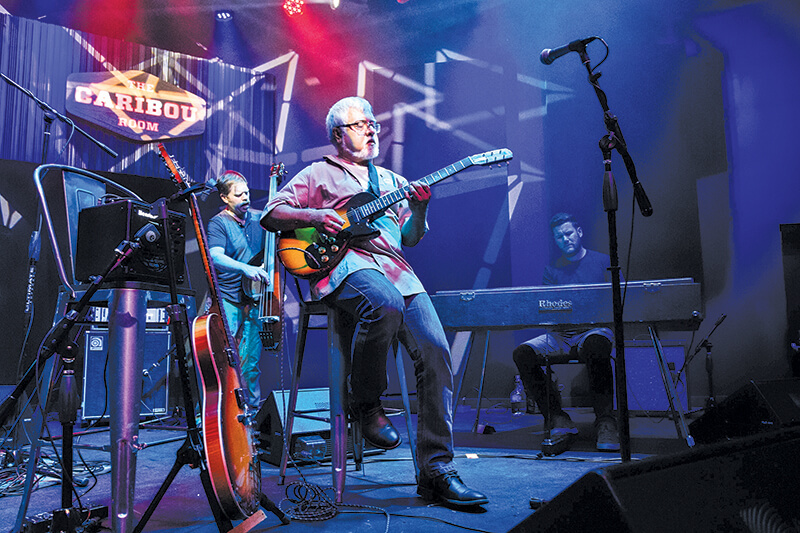Virtuoso Guitarist on Navigating the World of Digital Royalties, Mastering His Craft and Staying Sane While Juggling Multiple Projects
Guitar virtuoso Fareed Haque is a master of many styles, from jazz to classical. Known for his work in Garaj Mahal, amongst many other career-spanning highlights, Haque recently joined the legendary fusion drummer Billy Cobham on tour, where we caught up with him for a few questions about his life, his playing style and his favorite instruments.
You’re from Chicago. I’m from there originally — where did you grow up in Chicago?
I grew up in Glen Ellyn, it’s west of Chicago about forty minutes. I went into the city from age 16 on, heading down to jam sessions on the south side, meeting Von Freeman and many other Chicago jazz legends and jamming regularly. I now run a small jazz festival in Glen Ellyn and it’s nice to bring jazz back to my hometown.
You’re known for utilizing modal and exotic scales that sound very different from traditional pentatonic blues. Did you get into blues while residing in Chicago?
Actually that’s wrong, I play almost exclusively traditional scales and pentatonic scales. What’s different is the way I use the pentatonic scales (bends and such) and the notes that I add into them to give them a raga like sound, while also retaining a soul jazz bluesy feeling. Check out my course JAZZ ROCK WORKSHOP, it goes deep into this. For example, if I have a D minor blues scale [D,F,G,A,C,D], it’s very common for traditional blues players to add in the F sharp [D,F, F#, G,A,C,D]. If you remove the F, you get D,F#,G,A,C,D, which is a very Indian sound – still a pentatonic scale, but basically a blues scale with one note left out….great sound!
What kind of music were you exposed to as a kid?
Everything, my folks are music lovers – my mother is from Chile, she sang and played a little guitar. I have fond memories of her trying to get through Spanish and Chilean folk songs. Later on my dad, who is from Pakistan, and mom, both played records of Indian music, jazz, and classical guitar music. They took me to see McCoy Tyner, Pat Metheny, Santana. When I started to play guitar, my mother bought home three records: Al Di Meola – Elegant Gypsy, Pat Martino – Joyous Lake, and Pat Metheny – Bright Size Life. That was a pretty good starter kit from mom! Later, we traveled a lot to France, Spain, Mexico, Canada, Iran, Pakistan and I was introduced to all kinds of music and musicians. At home, I listened to American radio and was into everything 1970s like Foghat, Rush, Led Zeppelin, etc. It was natural for me to embrace all of this and it melded together very easily and subconsciously.
Who were some of your influences when you first playing guitar?
Classical guitar influences were Jose Rey de la Torre, from his album Romantic Guitar that we had at home. I just love his tone and elegant phrasing. After that I fell for Al Di Meola and Paco De Lucia, then John McLaughlin and Pat Martino and later on Grant Green, Wes Montgomery and Jim Hall. Of course from there, John Williams, Julian Bream, Andres Segovia and the Romeros were huge.

Let’s talk a little bit about Garaj Mahal. In my opinion, Garaj Mahal is one of the most innovative jazz rock bands, like a second incarnation of Mahavishnu Orchestra. You guys did a short tour recently, how did that go?
Great! Garaj Mahal has a fantastic new drummer named Hassan Hurd and the great Oz Ezzeldin is hitting on keys, so we will be touring and recording again soon! Kai and I have lots of new music written.
You’re in like five different acts from Fareed Haque and Flat Earth to Goran Ivanovic and Fareed Haque duo, your own classical guitar act…all of these groups have a different and diverse set of sounds. What’s your process of mental preparation so that you can memorize all of the music for these different bands?
I think ahead, in every sense of the word. I go through music in my head, both visually and theoretically, often months before shows or tours. Then once it is memorized, it’s usually there for keeps, with the occasional brush up. But the key is knowing the music, and preparing carefully and slowly enough so that the memory process is lasting and comprehensive. Also, I read pretty well for a guitarist so I can notate and then read to refresh if needed.
How do you recruit the musicians for your projects?
Groove and time, chops and tradition are important…but mostly I need to play with players who are a good hang and are willing to take risks and mess up now and then. Otherwise, the process isn’t fun and audiences pick up on that.
When did you first learn about music business contracts and how to collect royalties for multiple recording projects?
I’m still learning! It’s so complicated, but so important to be proactive about this stuff. The music world has NOT really changed that much in some essential ways. Spotify, YouTube, Sirius etc. are all basically new forms of radio. And getting “airplay” is still what it’s all about. A few calls to DJs and adds to playlists and I can see the increase in payouts – and even though these streaming services pay very little, they actually pay as well if not more than traditional radio.
So, for those folks complaining about the music business, well I like to say, “That ship sailed a long time ago!” We should have been fighting for better rates in the 1960s and pushed for better royalties, more tracking of radio and elevator music, but we, musicians and musicians’ unions, started giving away music for free in the 1950s. Now we complain? Way too little too late and don’t tell me “live music is best.” I LOVE live music, but really? You’re going to tell me that a recording of Arthur Rubenstein or Lang Lang for free on the radio is worse than a mediocre pianist playing in a bad room with people burping, farting and coughing? Come on! The only thing we have to offer as live musicians is spontaneity, so improvise.
You are currently a professor at Northern Illinois University. Was it always your objective to become a music professor after you had finished touring?
Nope, never…I literally got a call out of the blue asking me to teach guitar at NIU. I had taught some at music stores etc., and thought this was just another teaching gig like those.
I am pretty organized mentally and teaching helped me organize my ideas even further, and that was helpful to most students. So, it’s been a win-win, but I’m not really a dedicated teacher, I’m just honest and try to be organized. This works well for serious students, not so well for casual students. Ah well, we could use a few less lazy students!
You’ve played with a lot of guitars over your career, but you’re mainly associated with semi-hollowbodies. What is your favorite kind of guitar to play?
Ideally, I’d like to play nylon and full-size archtop guitars, but they are hard to amplify so for many years I’ve played L5-S guitars like Pat Martino’s. I LOVE the sound and even-ness of tone, sustain and articulation, however I’ve found that it was not great for touring…it sounded good in 1 out of 20 amps and was super heavy. Recently Brian Galloup and Sam Guidry have built a beautiful set of prototype guitars that we hope to eventually refine into a Fareed Haque Model. This is a brilliant concept that virtually eliminates feedback issues with arch-tops, while at the same time creating incredible sustain and playability across the register. Basically this is a CNC carved, full depth arch-top with a flat back, no f-holes and a sound post to tune, all connected dynamically and ergonomically. The result is a very musical and traditional sounding and looking guitar, with most of the problems of traditional archtop guitars eliminated. No wolf notes and great sustain even up to the very highest notes on the low strings, so comping way up high and even on upper frets of low strings is no problem, and effects work great too.
You also use a Moog guitar and sometimes Stratocaster. Has Fender or Moog ever approached you about designing a guitar?
Actually I was the beta tester and one of the original Moog guitar guys. I think mine is number 006 or 007? It was a great concept, but way too pricey and kind of a waste of technology on a guitar that was not a good fit. If you are building a guitar with infinite sustain, then why build a guitar with no attack and great sustain? It would have been cooler to build a very rootsy guitar, cheaply like a Stratocaster or Mustang or Jazzmaster and then add in the crazy sustain pickups, etc. Moog didn’t really get the guitar market I think and eventually discontinued the model. I was hoping they’d build an archtop version, but they never got around to it. I sure enjoy playing it though!
What local amp or effects pedal builders are you’re digging, if any?
Been into the Sonicake Twiggy Blues pedal. It’s a fly-rig pedal with delay, amp simulation, reverb, distortion and compression. Great tones in a tiny package, for that gig where the amp sucks or doesn’t even show up! Fits in your gig bag and sounds sweet.
I’m also an Henriksen endorser and Goran and I are endorsing Lyon and Healy classical guitars and Acus acoustic amps and preamps. These are great products for amplifying classical guitar. And of course, I am using the Galloup guitars as well as the Relish solid body for the upcoming Billy Cobham Tour.

Let’s talk a bit about your current projects. What do you have that’s new in the works?
Currently focusing on a few classical projects – I have a CD with a string quartet that has been doing really well and is something I’m proud of.
Also Goran and I, Flat Earth Ensemble, Tony Monaco and the Billy Cobham band all have new CDs in the works. These are probably my best work to date, I’m super excited to get these albums out. My own solo project is something quite different. A few years back, guitar great Mark Ribot sent me a stack of music by a Haitian guitarist and composer named Frantz Casseus. The more I played this music, the more I’ve fallen in love with it, and eventually ended up recording an albums worth of his music with my own band. I am drawn to the great songs of Latin America that have mostly been ignored by jazz guitarists. So, look for more of this blend of jazz, Latin and classical guitar in the next few CDs. Starting with Casseus!
Any last words?
Oh dang and here I thought it was going so well…can I get a blindfold, cigarette, last meal maybe? Well…hope to see you at the show!
photos by James DeWalt Photography
